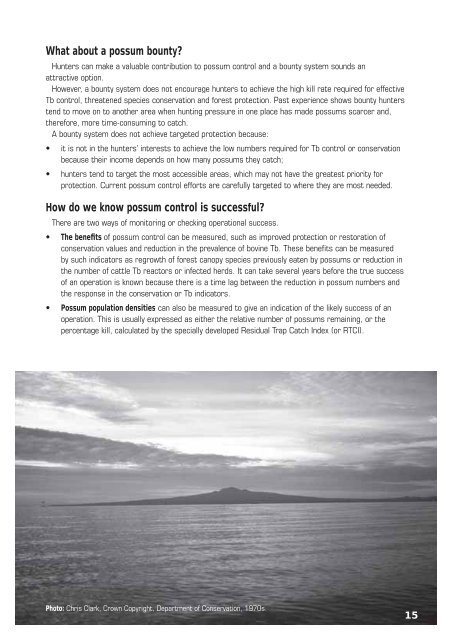National Possum Control Agencies - Department of Conservation
National Possum Control Agencies - Department of Conservation
National Possum Control Agencies - Department of Conservation
You also want an ePaper? Increase the reach of your titles
YUMPU automatically turns print PDFs into web optimized ePapers that Google loves.
What about a possum bounty?<br />
Hunters can make a valuable contribution to possum control and a bounty system sounds an<br />
attractive option.<br />
However, a bounty system does not encourage hunters to achieve the high kill rate required for effective<br />
Tb control, threatened species conservation and forest protection. Past experience shows bounty hunters<br />
tend to move on to another area when hunting pressure in one place has made possums scarcer and,<br />
therefore, more time-consuming to catch.<br />
A bounty system does not achieve targeted protection because:<br />
• it is not in the hunters’ interests to achieve the low numbers required for Tb control or conservation<br />
because their income depends on how many possums they catch;<br />
• hunters tend to target the most accessible areas, which may not have the greatest priority for<br />
protection. Current possum control efforts are carefully targeted to where they are most needed.<br />
How do we know possum control is successful?<br />
There are two ways <strong>of</strong> monitoring or checking operational success.<br />
• The benefi ts <strong>of</strong> possum control can be measured, such as improved protection or restoration <strong>of</strong><br />
conservation values and reduction in the prevalence <strong>of</strong> bovine Tb. These benefi ts can be measured<br />
by such indicators as regrowth <strong>of</strong> forest canopy species previously eaten by possums or reduction in<br />
the number <strong>of</strong> cattle Tb reactors or infected herds. It can take several years before the true success<br />
<strong>of</strong> an operation is known because there is a time lag between the reduction in possum numbers and<br />
the response in the conservation or Tb indicators.<br />
• <strong>Possum</strong> population densities can also be measured to give an indication <strong>of</strong> the likely success <strong>of</strong> an<br />
operation. This is usually expressed as either the relative number <strong>of</strong> possums remaining, or the<br />
percentage kill, calculated by the specially developed Residual Trap Catch Index (or RTCI).<br />
Photo: Chris Clark, Crown Copyright, <strong>Department</strong> <strong>of</strong> <strong>Conservation</strong>, 1970s.<br />
15

















